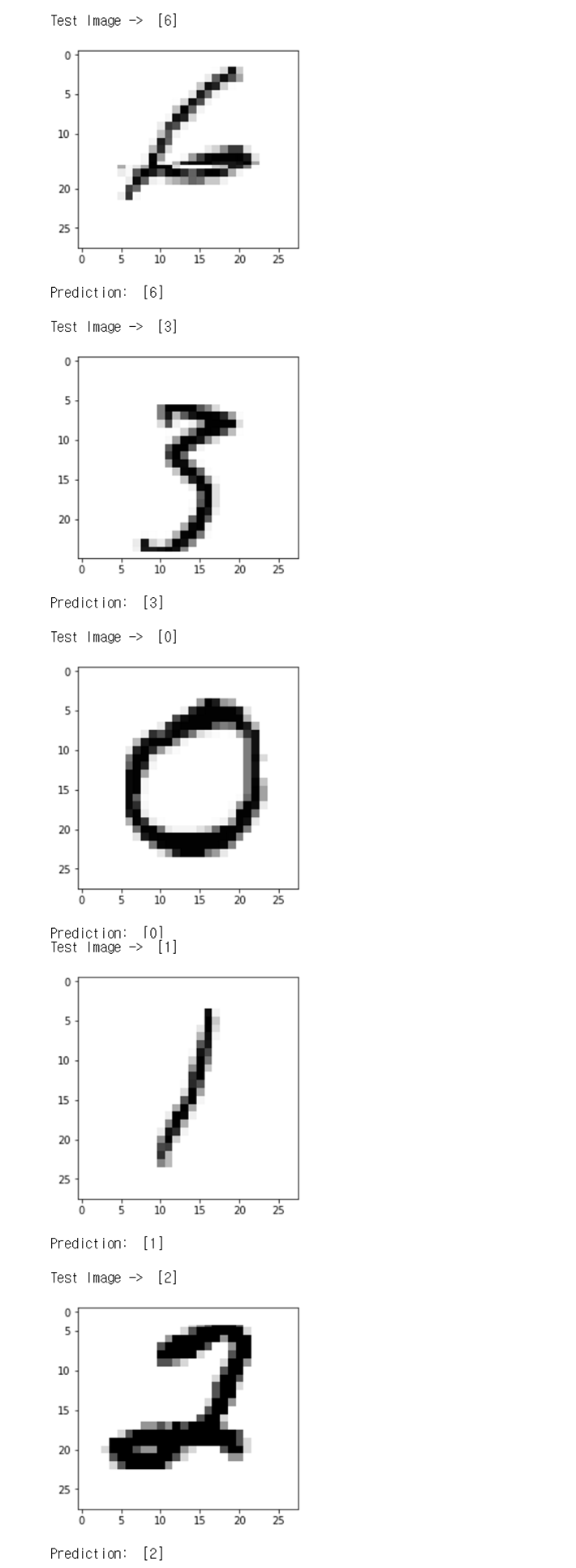@markdown
# TensorFlow MNIST 데이터 셋 이용한 손 글씨 인식 학습모델 구현
<br/>
## MNIST 손글씨 인식 모델 기본 소스코드
____
<pre><code class="python" style="font-size:15px">import tensorflow as tf
import random
import matplotlib.pyplot as plt
from tensorflow.examples.tutorials.mnist import input_data
# one_hot encoding 옵션
mnist = input_data.read_data_sets("MNIST_data/", one_hot=True)
# 0~9까지 숫자 10개
nb_classes = 10
X = tf.placeholder(tf.float32, [None, 784])
Y = tf.placeholder(tf.float32, [None, nb_classes])
W = tf.Variable(tf.random_normal([784, nb_classes]))
b = tf.Variable(tf.random_normal([nb_classes]))
hypothesis = tf.nn.softmax(tf.matmul(X, W) + b)
cost = tf.reduce_mean(-tf.reduce_sum(Y * tf.log(hypothesis), axis=1))
optimizer = tf.train.GradientDescentOptimizer(learning_rate=0.1).minimize(cost)
is_correct = tf.equal(tf.arg_max(hypothesis, 1), tf.arg_max(Y, 1))
accuracy = tf.reduce_mean(tf.cast(is_correct, tf.float32))
training_epochs = 20 # 전체 데이터셋 학습시킬 횟수
batch_size = 100 # 한번에 실행시킬 데이터 갯수
with tf.Session() as sess:
sess.run(tf.global_variables_initializer())
for epoch in range(training_epochs):
avg_cost = 0
total_batch = int(mnist.train.num_examples / batch_size)
for i in range(total_batch):
batch_xs, batch_ys = mnist.train.next_batch(batch_size)
c, _ = sess.run([cost, optimizer], feed_dict={X:batch_xs, Y:batch_ys})
avg_cost += c / total_batch
print('Epoch:', '%04d' % (epoch + 1), '| cost =', '{:.9f}'.format(avg_cost))
print("---------------------------------------------------------------------")
print("Learning finished")
print("Accuracy : ", accuracy.eval(session=sess, feed_dict={X: mnist.test.images, Y: mnist.test.labels}))
for epoch in range(5):
r = random.randint(0, mnist.test.num_examples - 1)
# print("Test Random Label: ", sess.run(tf.argmax(mnist.test.labels[r:r + 1], 1)))
print("\nTest Image -> ", sess.run(tf.argmax(mnist.test.labels[r:r + 1], 1)))
plt.imshow(mnist.test.images[r:r + 1].reshape(28, 28), cmap='Greys', interpolation='nearest')
plt.show()
print("Prediction: ", sess.run(tf.argmax(hypothesis, 1), feed_dict={X: mnist.test.images[r:r + 1]}))
</code></pre>
<pre><code class="python" style="font-size:15px">실행결과
Epoch: 0001 | cost = 2.881752090
...
Epoch: 0020 | cost = 0.412588274
---------------------------------------------------------------------
Learning finished
Accuracy : 0.894
</code></pre>

## MNIST Neural Network 적용한 모델 소스코드
____
<pre><code class="python" style="font-size:15px">import tensorflow as tf
import random
import matplotlib.pyplot as plt
from tensorflow.examples.tutorials.mnist import input_data
# one_hot encoding 옵션
mnist = input_data.read_data_sets("MNIST_data/", one_hot=True)
# 0~9까지 숫자 10개
nb_classes = 10
X = tf.placeholder(tf.float32, [None, 784])
Y = tf.placeholder(tf.float32, [None, nb_classes])
# Neural Network 구성
W1 = tf.Variable(tf.random_normal([784, 256]))
b1 = tf.Variable(tf.random_normal([256]))
L1 = tf.sigmoid(tf.matmul(X, W1) + b1)
W2 = tf.Variable(tf.random_normal([256, 256]))
b2 = tf.Variable(tf.random_normal([256]))
L2 = tf.sigmoid(tf.matmul(L1, W2) + b2)
W3 = tf.Variable(tf.random_normal([256, nb_classes]))
b3 = tf.Variable(tf.random_normal([nb_classes]))
hypothesis = tf.nn.softmax(tf.matmul(L2, W3) + b3)
cost = tf.reduce_mean(-tf.reduce_sum(Y * tf.log(hypothesis), axis=1))
optimizer = tf.train.GradientDescentOptimizer(learning_rate=0.1).minimize(cost)
is_correct = tf.equal(tf.arg_max(hypothesis, 1), tf.arg_max(Y, 1))
accuracy = tf.reduce_mean(tf.cast(is_correct, tf.float32))
training_epochs = 20 # 전체 데이터셋 학습시킬 횟수
batch_size = 100 # 한번에 실행시킬 데이터 갯수
with tf.Session() as sess:
sess.run(tf.global_variables_initializer())
for epoch in range(training_epochs):
avg_cost = 0
total_batch = int(mnist.train.num_examples / batch_size)
for i in range(total_batch):
batch_xs, batch_ys = mnist.train.next_batch(batch_size)
c, _ = sess.run([cost, optimizer], feed_dict={X:batch_xs, Y:batch_ys})
avg_cost += c / total_batch
print('Epoch:', '%04d' % (epoch + 1), '| cost =', '{:.9f}'.format(avg_cost))
print("---------------------------------------------------------------------")
print("Learning finished")
print("Accuracy : ", accuracy.eval(session=sess, feed_dict={X: mnist.test.images, Y: mnist.test.labels}))
for epoch in range(training_epochs):
r = random.randint(0, mnist.test.num_examples - 1)
# print("Test Random Label: ", sess.run(tf.argmax(mnist.test.labels[r:r + 1], 1)))
print("\nTest Image -> ", sess.run(tf.argmax(mnist.test.labels[r:r + 1], 1)))
plt.imshow(mnist.test.images[r:r + 1].reshape(28, 28), cmap='Greys', interpolation='nearest')
plt.show()
print("Prediction: ", sess.run(tf.argmax(hypothesis, 1), feed_dict={X: mnist.test.images[r:r + 1]}))
</code></pre>
<pre><code class="python" style="font-size:15px">MNIST NN 실행결과
Epoch: 0001 | cost = 1.838566279
...
Epoch: 0020 | cost = 0.191526052
---------------------------------------------------------------------
Learning finished
Accuracy : 0.9128
</code></pre>
- MNIST 데이터셋을 활용해 손글씨 숫자 이미지를 학습 시켜, 테스트 이미지를 입력했을때 예측하는 모델을 구현해보았다.
- 실행결과 Neural Network를 구성한 학습 모델의 정확도가 조금 더 높았다.
- Input, Output layer의 neuron 갯수, epoch 횟수, layer를 여러 층 구성한 hypothesis에 따라 정확도가 달라지는 것을 확인할 수 있었다.
> 소스코드 - 모두를 위한 머신러닝 김석훈 교수님 강의 참고 : ([https://hunkim.github.io/ml/](https://hunkim.github.io/ml/))
'Deep Learning' 카테고리의 다른 글
| TensorFlow - RNN 기초 (0) | 2017.08.25 |
|---|---|
| TensorFlow - MNIST ReLU, Xavier 초기화, Dropout 적용하여 정확도 높이기 (0) | 2017.08.15 |
| TensorFlow - Neural Network XOR 문제 (4) | 2017.08.03 |
| TensorFlow - Learning Rate, Data Preprocessing, Overfitting (0) | 2017.08.01 |
| TensorFlow - Softmax Regression(2) (0) | 2017.07.13 |